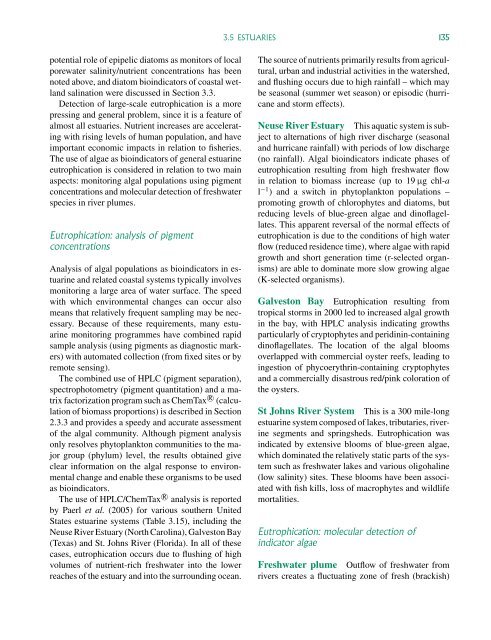Freshwater Algae: Identification and Use as Bioindicators
Freshwater Algae: Identification and Use as Bioindicators
Freshwater Algae: Identification and Use as Bioindicators
You also want an ePaper? Increase the reach of your titles
YUMPU automatically turns print PDFs into web optimized ePapers that Google loves.
3.5 ESTUARIES 135potential role of epipelic diatoms <strong>as</strong> monitors of localporewater salinity/nutrient concentrations h<strong>as</strong> beennoted above, <strong>and</strong> diatom bioindicators of co<strong>as</strong>tal wetl<strong>and</strong>salination were discussed in Section 3.3.Detection of large-scale eutrophication is a morepressing <strong>and</strong> general problem, since it is a feature ofalmost all estuaries. Nutrient incre<strong>as</strong>es are acceleratingwith rising levels of human population, <strong>and</strong> haveimportant economic impacts in relation to fisheries.The use of algae <strong>as</strong> bioindicators of general estuarineeutrophication is considered in relation to two main<strong>as</strong>pects: monitoring algal populations using pigmentconcentrations <strong>and</strong> molecular detection of freshwaterspecies in river plumes.Eutrophication: analysis of pigmentconcentrationsAnalysis of algal populations <strong>as</strong> bioindicators in estuarine<strong>and</strong> related co<strong>as</strong>tal systems typically involvesmonitoring a large area of water surface. The speedwith which environmental changes can occur alsomeans that relatively frequent sampling may be necessary.Because of these requirements, many estuarinemonitoring programmes have combined rapidsample analysis (using pigments <strong>as</strong> diagnostic markers)with automated collection (from fixed sites or byremote sensing).The combined use of HPLC (pigment separation),spectrophotometry (pigment quantitation) <strong>and</strong> a matrixfactorization program such <strong>as</strong> ChemTax R○ (calculationof biom<strong>as</strong>s proportions) is described in Section2.3.3 <strong>and</strong> provides a speedy <strong>and</strong> accurate <strong>as</strong>sessmentof the algal community. Although pigment analysisonly resolves phytoplankton communities to the majorgroup (phylum) level, the results obtained giveclear information on the algal response to environmentalchange <strong>and</strong> enable these organisms to be used<strong>as</strong> bioindicators.The use of HPLC/ChemTax R○ analysis is reportedby Paerl et al. (2005) for various southern UnitedStates estuarine systems (Table 3.15), including theNeuse River Estuary (North Carolina), Galveston Bay(Tex<strong>as</strong>) <strong>and</strong> St. Johns River (Florida). In all of thesec<strong>as</strong>es, eutrophication occurs due to flushing of highvolumes of nutrient-rich freshwater into the lowerreaches of the estuary <strong>and</strong> into the surrounding ocean.The source of nutrients primarily results from agricultural,urban <strong>and</strong> industrial activities in the watershed,<strong>and</strong> flushing occurs due to high rainfall – which maybe se<strong>as</strong>onal (summer wet se<strong>as</strong>on) or episodic (hurricane<strong>and</strong> storm effects).Neuse River Estuary This aquatic system is subjectto alternations of high river discharge (se<strong>as</strong>onal<strong>and</strong> hurricane rainfall) with periods of low discharge(no rainfall). Algal bioindicators indicate ph<strong>as</strong>es ofeutrophication resulting from high freshwater flowin relation to biom<strong>as</strong>s incre<strong>as</strong>e (up to 19 µg chl-al −1 ) <strong>and</strong> a switch in phytoplankton populations –promoting growth of chlorophytes <strong>and</strong> diatoms, butreducing levels of blue-green algae <strong>and</strong> dinoflagellates.This apparent reversal of the normal effects ofeutrophication is due to the conditions of high waterflow (reduced residence time), where algae with rapidgrowth <strong>and</strong> short generation time (r-selected organisms)are able to dominate more slow growing algae(K-selected organisms).Galveston Bay Eutrophication resulting fromtropical storms in 2000 led to incre<strong>as</strong>ed algal growthin the bay, with HPLC analysis indicating growthsparticularly of cryptophytes <strong>and</strong> peridinin-containingdinoflagellates. The location of the algal bloomsoverlapped with commercial oyster reefs, leading toingestion of phycoerythrin-containing cryptophytes<strong>and</strong> a commercially dis<strong>as</strong>trous red/pink coloration ofthe oysters.St Johns River System This is a 300 mile-longestuarine system composed of lakes, tributaries, riverinesegments <strong>and</strong> springsheds. Eutrophication w<strong>as</strong>indicated by extensive blooms of blue-green algae,which dominated the relatively static parts of the systemsuch <strong>as</strong> freshwater lakes <strong>and</strong> various oligohaline(low salinity) sites. These blooms have been <strong>as</strong>sociatedwith fish kills, loss of macrophytes <strong>and</strong> wildlifemortalities.Eutrophication: molecular detection ofindicator algae<strong>Freshwater</strong> plume Outflow of freshwater fromrivers creates a fluctuating zone of fresh (brackish)
















